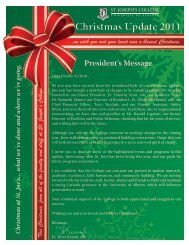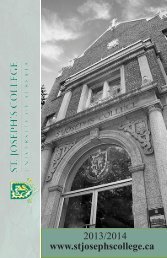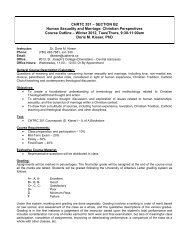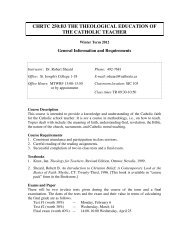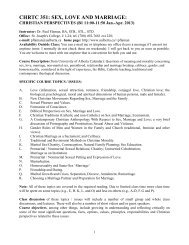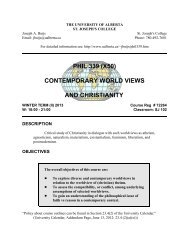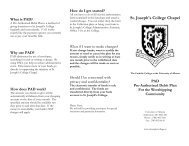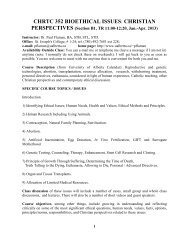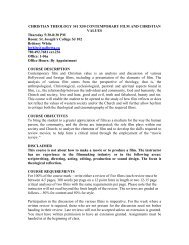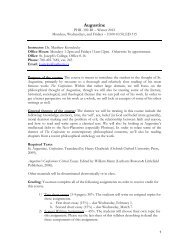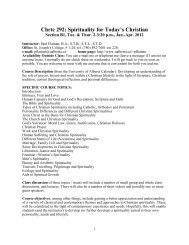CHRTC 351 â Section B1/B2 - St. Joseph's College - University of ...
CHRTC 351 â Section B1/B2 - St. Joseph's College - University of ...
CHRTC 351 â Section B1/B2 - St. Joseph's College - University of ...
You also want an ePaper? Increase the reach of your titles
YUMPU automatically turns print PDFs into web optimized ePapers that Google loves.
<strong>CHRTC</strong> 393 – SECTION <strong>B1</strong><br />
The Human Sexual Body: Theological Perspectives<br />
Course Outline – Winter 2012<br />
Doris M. Kieser<br />
Instructor:<br />
Doris M. Kieser, PhD<br />
Phone: (780) 492-7681, ext. 240<br />
Email:<br />
dkieser@ualberta.ca<br />
Office: #013, <strong>St</strong>. Joseph‟s <strong>College</strong> (Downstairs – Central staircase)<br />
Office Hours: Wednesday, 11:00 – 12:00; Or By Appointment<br />
General Course Description (Calendar):<br />
Objectives:<br />
The sexual body: desire, pain, pleasure, suffering, ecstasy; universal, particular, sacred, pr<strong>of</strong>ane. This<br />
course will consider a variety <strong>of</strong> historical and contemporary perspectives on the sexual body in Christian<br />
thought. Topics might include views <strong>of</strong> notable thinkers in Christian history, Pope John Paul II‟s “Theology<br />
<strong>of</strong> the Body”, theologies <strong>of</strong> the erotic, and feminist body theologies. We might also consider the influences<br />
<strong>of</strong> other disciplines on theological constructions <strong>of</strong> human sexual bodies.<br />
<br />
<br />
<br />
<br />
To introduce theological and other theoretical perspectives on the human body.<br />
To explore practical implications <strong>of</strong> body theories.<br />
To engage varied portrayals <strong>of</strong> the human sexual body in contemporary culture.<br />
To draw from a multitude <strong>of</strong> sources, including human experience, revelation, Christian Tradition, Catholic<br />
teaching and theological discussion, and other disciplines.<br />
Text:<br />
<br />
<strong>CHRTC</strong> 393 Readings – On Reserve, <strong>St</strong>. Joseph‟s <strong>College</strong> Library<br />
Course Requirements:<br />
Class preparation and participation – 20%<br />
Essay Assignment #1 – 35%<br />
Essay Assignment #2 – 45% (40% for the written work; 5% for in-class presentation)<br />
Grading:<br />
Assignments will be marked in percentages. The final letter grade will be assigned at the end <strong>of</strong> the course once<br />
all the marks are tallied. <strong>St</strong>udents will be graded following the <strong>University</strong> <strong>of</strong> Alberta‟s Letter grading system as<br />
follows:<br />
A+, A, A- Excellent<br />
B+, B, B- Good<br />
C+, C, C- Satisfactory<br />
D+ Poor<br />
D<br />
Minimum Pass<br />
F<br />
Failure<br />
Under this system, marking and grading are done separately. Grading involves a ranking in order <strong>of</strong> merit based<br />
on raw scores, and assessment <strong>of</strong> the class as a whole, and the qualitative descriptions <strong>of</strong> the various grades.<br />
Grading is in the first instance a judgement <strong>of</strong> the instructor based upon the student‟s total performance and<br />
includes consideration not only <strong>of</strong> marks earned for term work and final examination, but also <strong>of</strong> meaningful class<br />
participation, completion <strong>of</strong> assignments, improving or deteriorating performance, a comparison <strong>of</strong> the class as a<br />
whole with other classes, etc.<br />
Plagiarism and Cheating:
<strong>University</strong> <strong>of</strong> Alberta Calendar (Appendix „A”, Code <strong>of</strong> <strong>St</strong>udent Behaviour; online:<br />
www.u<strong>of</strong>aweb.ualberta.ca/gfcpolicymanual/content.cfm?ID_page=37633 ):<br />
<strong>Section</strong> 30.3.2 – Inappropriate Academic Behaviour:<br />
<strong>Section</strong> 30.3.2 (1) Plagiarism:<br />
No <strong>St</strong>udent shall submit the words, ideas, images or data <strong>of</strong> another person as the <strong>St</strong>udent‟s own in any academic<br />
writing, essay, thesis, project, assignment, presentation or poster in a course or program <strong>of</strong> study.<br />
<strong>Section</strong> 30.3.2(2) Cheating:<br />
(a) No <strong>St</strong>udent shall in the course <strong>of</strong> an examination or other similar activity, obtain or attempt to obtain information from<br />
another <strong>St</strong>udent or other unauthorized source, give or attempt to give information to another <strong>St</strong>udent, or use, attempt<br />
to use or possess for the purposes <strong>of</strong> use any unauthorized material.<br />
(b) No <strong>St</strong>udent shall represent or attempt to represent him or herself as another or have or attempt to have himself or<br />
herself represented by another in the taking <strong>of</strong> an examination, preparation <strong>of</strong> a paper or other similar activity. See<br />
also misrepresentation in 30.3.6(4).<br />
(c) No <strong>St</strong>udent shall represent another‟s substantial editorial or compositional assistance on an assignment as the<br />
<strong>St</strong>udent‟s own work.<br />
(d) No <strong>St</strong>udent shall submit in any course or program <strong>of</strong> study, without the written approval <strong>of</strong> the course Instructor, all or<br />
a substantial portion <strong>of</strong> any academic writing, essay, thesis, research report, project, assignment, presentation or<br />
poster for which credit has previously been obtained by the <strong>St</strong>udent or which has been or is being submitted by the<br />
<strong>St</strong>udent in another course or program <strong>of</strong> study in the <strong>University</strong> or elsewhere.<br />
(e) No <strong>St</strong>udent shall submit in any course or program <strong>of</strong> study any academic writing, essay, thesis, report, project,<br />
assignment, presentation or poster containing a statement <strong>of</strong> fact known by the <strong>St</strong>udent to be false or a reference to a<br />
source the <strong>St</strong>udent knows to contain fabricated claims (unless acknowledged by the <strong>St</strong>udent), or a fabricated<br />
reference to a source.<br />
<strong>Section</strong> 30.3.2 (3) Misuse <strong>of</strong> Confidential Materials:<br />
No student shall procure, distribute, or receive any confidential academic material such as pending examinations,<br />
laboratory results, or the content there<strong>of</strong> from any source without prior and express consent <strong>of</strong> the Instructor.<br />
Required Notes:<br />
Policy about course outlines can be found in 23.4(2) <strong>of</strong> the <strong>University</strong> Calendar (GFC 29 SEP 2003).<br />
The <strong>University</strong> <strong>of</strong> Alberta is committed to the highest standards <strong>of</strong> academic integrity and honesty. <strong>St</strong>udents are<br />
expected to be familiar with these standards regarding academic honesty and to uphold the policies <strong>of</strong> the <strong>University</strong><br />
in this respect. <strong>St</strong>udents are particularly urged to familiarize themselves with the provisions <strong>of</strong> the Code <strong>of</strong> <strong>St</strong>udent<br />
Behaviour (online at www.ualberta.ca/secretariat/appeals.htm) and avoid any behaviour which could potentially result<br />
in suspicions <strong>of</strong> cheating, plagiarism, misrepresentation <strong>of</strong> facts and/or participation in an <strong>of</strong>fence. Academic<br />
dishonesty is a serious <strong>of</strong>fence and can result in suspension or expulsion from the <strong>University</strong> (GFC 29 SEP 2003).<br />
2<br />
Course Outline:<br />
I. Introduction:<br />
An overview <strong>of</strong> some questions in contemporary discourse about the human sexual body, including<br />
attention to Scripture, theology, Church teaching, and human experiences.<br />
II. Human Sexual Body:<br />
An exploration <strong>of</strong> issues and questions related to the body in Scripture, the Incarnation, the Christian<br />
medieval, mystical understandings <strong>of</strong> the body, and Pope John Paul II‟s “Theology <strong>of</strong> the Body” (both<br />
sympathetic and critical views).<br />
III. The Body in Context:<br />
A consideration <strong>of</strong> the varied manifestations <strong>of</strong> the human body in lived experience, for example, male<br />
and female bodies, challenged bodies, the body in bioethics, and bodies in a consumer society.<br />
Resources:<br />
<strong>St</strong>. Joseph‟s <strong>College</strong> Library – downstairs in the <strong>College</strong>, accessible from the east entrance to the building<br />
(facing the Education building). NEOS library system.<br />
Course Requirements:<br />
1. Assignment # 1 - Essay:
35% - Tuesday, February 28 by the end <strong>of</strong> class. Late papers will be docked 5% per day late.<br />
No papers will be accepted after Tuesday, March 6. Your essay will integrate theological/ethical<br />
reflection on course materials with a discussion <strong>of</strong> one <strong>of</strong> the possible essay topics. Your essay<br />
must address one <strong>of</strong> the four possible assignments.<br />
See list <strong>of</strong> assignments from which to choose.<br />
All assignment materials are on Reserve in <strong>St</strong>. Joseph’s <strong>College</strong> Library.<br />
3<br />
2. Assignment #2 - Research Essay:<br />
45% - Thursday, April 12 (last class) by the end <strong>of</strong> class. Late papers will be docked 5% per<br />
day late. No papers will be accepted after Thursday, April 19.<br />
Your essay will address a topic <strong>of</strong> your choosing related to the course. Information to follow.<br />
3. Class Participation:<br />
20% - This requirement is based upon class attendance, significant and relevant contributions<br />
(including one-minute feedback at the start <strong>of</strong> each class), familiarity with readings, and general<br />
performance in class. This mark is assigned at my own discretion.<br />
Note: If you have any questions, queries, or problems related to the course, I am happy to meet with you either<br />
during my <strong>of</strong>fice hours, or at another time mutually convenient to us.<br />
__________________________________________________________________________________________<br />
____________________________________________________________<br />
<strong>CHRTC</strong> 393, <strong>B1</strong> – Winter 2012<br />
Reading Assignments<br />
WEEK 1 (January 10, 12) - Introduction:<br />
Moltmann-Wendel, Elizabeth. (1995). I Am My Body: A Theology <strong>of</strong> Embodiment. John Bowden (trans.).<br />
New York: Continuum; 103-105. (108pp.; ISBN: 0-8264-0786-2)<br />
Genesis 2-3. (2009). Bible, New Revised <strong>St</strong>andard Version. Bible <strong>St</strong>udy Tools. Available at:<br />
http://www.biblestudytools.com/.<br />
Clifford, Richard J. & Murphy, Roland E. (1990). Genesis. In Raymond E. Brown, Joseph A. Fitzmeyer, &<br />
Roland E. Murphy (Eds.), The New Jerome Biblical Commentary, pp. 8-13. Englewood Cliffs, NJ:<br />
Prentice Hall. (1484pp.; ISBN: 0-13-614934-0)<br />
WEEK 2 (January 17, 19) – Sexual and Sexed Bodies:<br />
John Paul II, Pope. (1993). Veritatis Splendor. Nn. 17-18; 43-50. Catholic Document Archive. Available at:<br />
http://www.catholic-pages.com/ documents/<br />
Paulsell, <strong>St</strong>ephanie. (2003). Honoring the Body: Meditations on a Christian Practice. San Francisco, CA:<br />
Jossey-Bass; 139-163, 186-187. (197pp.; ISBN: 0-7879-6757-2)<br />
Farley, Margaret A. (2006). Just Love: A Framework for Christian Sexual Ethics. New York, NY:<br />
Continuum; 133-158. (322pp.; ISBN: 0-8264-1001-4)<br />
WEEK 3 (January 24, 26) – Biblical Bodies: The Song <strong>of</strong> Songs:<br />
Song <strong>of</strong> Songs. (2009). Bible, New Revised <strong>St</strong>andard Version. Rosetta. Available at:<br />
http://www.reltech.org/ECanon/search.php?qry=song+<strong>of</strong>+solomon&vrs=NRSV.
Murphy, Roland E. (1990). Canticle <strong>of</strong> Canticles. In Raymond E. Brown, Joseph A. Fitzmeyer, & Roland<br />
E. Murphy (Eds.), The New Jerome Biblical Commentary, pp. 462-465. Englewood Cliffs, NJ:<br />
Prentice Hall. (1484pp.; ISBN: 0-13-614934-0)<br />
Trible, Phyllis. (1978). God and the Rhetoric <strong>of</strong> Sexuality. Philadelphia: Fortress Press; 144-165.<br />
(206pp.; ISBN: 0-8006-0464-4)<br />
4<br />
WEEK 4 (January 31, February 2) – Incarnation:<br />
Schneiders, Sandra M. (1986). Women and the Word: The Gender <strong>of</strong> God in the New Testament and the<br />
Spirituality <strong>of</strong> Women. New York, NY: Paulist Press; 50-71, 79-80. (81pp.; ISBN: 0-8091-2802-<br />
0)<br />
Ross, Susan A. (2004). Can God Be a Bride? America. November 1, 2004. Available at:<br />
http://www.americamagazine.org/content/article.cfm?article_id=3838.<br />
Jordan, Mark D. (2007). God‟s Body. In Gerard Loughlin (Ed.), Queer Theology: Rethinking the Western<br />
Body, pp. 281-292. Oxford, UK: Blackwell Publishing. (<strong>351</strong>pp.; ISBN: 978-0-631-21608-7)<br />
WEEK 5 (February 7, 9) – Mystical Medieval Bodies:<br />
Julian <strong>of</strong> Norwich. (1974). The Revelations <strong>of</strong> Divine Love. James Walsh (trans.). <strong>St</strong>. Meinrad, IN: Abbey<br />
Press; 156-160. (210pp.; ISBN: N/A)<br />
Hildegard <strong>of</strong> Bingen. (1994). Holistic Healing. Manfred Pawlik, Patrick Madigan, & John Kulas (trans.).<br />
<strong>College</strong>ville, MN: The Liturgical Press; 54-71, 121-123. (223pp.; ISBN: 0-8146-2224-0)<br />
Bynum, Caroline. (1995). Why All the Fuss about the Body? A Medievalist‟s Perspective. Critical Inquiry<br />
22 (Autumn 1995), 1-33. (ISSN: 0093-1896)<br />
WEEK 6 (February 14, 16) – Pope John Paul II, Theology <strong>of</strong> the Body, Sympathetic:<br />
John Paul II, Pope. (1997). The Theology <strong>of</strong> the Body: Human Love in the Divine Plan. Boston, MA:<br />
Daughters <strong>of</strong> <strong>St</strong>. Paul, 54-66, 97-98. (ISBN: 0-8198-7394-2)<br />
Shivanandan, Mary. (2001). John Paul II‟s Theology <strong>of</strong> the Body. The Living Light 37 (3), 67-74. (ISSN:<br />
0024-5275)<br />
Miller, Paula Jean. (2001). The Theology <strong>of</strong> the Body: A New Look at Humanae Vitae. Theology Today 57<br />
(4), 501-508. (ISSN: 0040-5736)<br />
WEEK 7 (February 20-24) – Reading Week – No Classes<br />
WEEK 8 (February 28, March 1) – Pope John Paul II, Theology <strong>of</strong> the Body, Critical:<br />
* Tuesday, February 28 – First Paper Due *<br />
Johnson, Luke Timothy. (2007). A Disembodied “Theology <strong>of</strong> the Body”: John Paul II on Love, Sex, and<br />
Pleasure. In Kieran Scott & Harold Daly Horell (Eds.), Human Sexuality in the Catholic Tradition,<br />
pp. 111-122. Lanham, MD: Rowman & Littlefield. (233pp.; ISBN: 978-0-7425-5241-8)<br />
Cloutier, David. (2006). Heaven Is a Place on Earth? Analyzing the Popularity <strong>of</strong> Pope John Paul II‟s<br />
Theology <strong>of</strong> the Body. In Lisa Sowle Cahill, John Garvey, & T. Frank Kennedy (Eds.), Sexuality<br />
and the U.S. Catholic Church: Crisis and Renewal, pp. 18-31, 200-203. New York, NY: Crossroad<br />
Publishing. (233pp.; ISBN: 978-0-8245-2408-1)<br />
WEEK 9 (March 6, 8) – Female Bodies:<br />
Jung, Patricia Beattie. (2000). Sexual Pleasure: A Roman Catholic Perspective on Women‟s Delight.<br />
Theology and Sexuality 12, 26-47. (ISSN: 1355-8358)
Bynum, Caroline Walker. (1987). Holy Feast and Holy Fast: The Religious Significance <strong>of</strong> Food to<br />
Medieval Women. Los Angeles, CA: <strong>University</strong> <strong>of</strong> California; 260-276, 406-413. (444pp.; ISBN:<br />
0-520-06329-5)<br />
WEEK 10 (March 13, 15) – Male Bodies:<br />
Nelson, James B. (1992). Body Theology. Louisville, KN: Westminster/John Knox Press; 93-104, 201-<br />
202. (216pp.; ISBN: 0-664-25379-2)<br />
Krondorfer, Bjorn. (1996). The Confines <strong>of</strong> Male Confessions: On Religion, Bodies, and Mirrors. In Bjorn<br />
Krondorfer (Ed.), Men’s Bodies, Men’s Gods: Male Identities in a (Post-)Christian Culture, pp.<br />
205-234. New York, NY: New York <strong>University</strong> Press. (324pp.; ISBN: 0-8147-4669-1)<br />
WEEK 11 (March 20, 22) – Challenged Bodies:<br />
Carmody, John T. & Carmody, Denise L. (1995). The Body Suffering: Illness and Disability. In Lisa Sowle<br />
Cahill & Margaret A. Farley (Eds.), Embodiment, Morality, and Medicine, pp. 185-197. Dordrecht,<br />
NL: Kluwer Academic Publishers. (223pp.; ISBN: 0-7923-3342-X)<br />
Reynolds, Thomas E. (2008). Vulnerable Communion: A Theology <strong>of</strong> Disability & Hospitality. Grand<br />
Rapids, MI: BrazosPress; 102 – 135. (256pp.; ISBN: 978-1-58743-177-7)<br />
WEEK 12 (March 27, 29) – Bodies and Bioethics:<br />
Campbell, Alastair V. (2009). The Body in Bioethics. New York, NY: Routledge-Cavendish; 1-10, 127; 75-<br />
93, 129. (150pp.; ISBN: 978-1-84472-056-9)<br />
Weaver, Darlene Fozard. (2007). Embryo Adoption Theologically Considered: Bodies, Adoption, and the<br />
Common Good. In Sarah-Vaughn Brakman & Darlene Fozard Weaver (Eds.), The Ethics <strong>of</strong><br />
Embryo Adoption and the Catholic Tradition: Moral Arguments, Economic Reality and Social<br />
Analysis, pp. 141-159. Springer. (326pp.; ISBN: 978-1-4020-6210-0)<br />
WEEK 13 (April 3, 5) – Consuming Bodies:<br />
Featherston, Mike. (2001). The Body in Consumer Culture. In Jessica R. Johnston (Ed.), The American<br />
Body in Context: An Anthology, pp. 79-103. Wilmington, DL: Scholarly Resources Inc. (335pp.;<br />
ISBN: 0-8420-2858-7)<br />
Cook, Daniel Thomas & Kaiser, Susan B. (2004). Betwixt and Be Tween: Age Ambiguity and the<br />
Sexualization <strong>of</strong> the Female Consuming Subject. (2004). Journal <strong>of</strong> Consumer Culture 4 (2), 203-<br />
227. (ISSN: 1469-5405)<br />
WEEK 14 (April 10, 12) – Show and Tell – Last Week <strong>of</strong> Class<br />
In this class you will each give a short presentation pertaining to your final essay topic. Your presentation<br />
can take any format you wish but it must not exceed 10 minutes. Your presentation will be<br />
considered in your mark on the paper.<br />
5
6<br />
Essay Assignment #1 - <strong>CHRTC</strong> 393<br />
The Human Sexual Body: Theological Perspectives<br />
Doris M. Kieser<br />
<br />
<br />
<br />
<br />
Your essay will integrate theological reflection on themes/topics covered in the course with an analysis <strong>of</strong> one<br />
<strong>of</strong> the assignments on the list provided. The focus <strong>of</strong> your essay is to be the topic/themes relevant to the<br />
course, not simply a summary and critique <strong>of</strong> the film/work.<br />
Choose the most relevant themes apparent in your chosen work. The themes suggested on the assignment<br />
list are only to facilitate your choice <strong>of</strong> topics.<br />
Your essay will be 8-10 pages in length. You will write in an acceptable academic format. Your essay will be<br />
typed (12 point font) and double-spaced with standard margins. The following qualities should be<br />
demonstrated in your essay:<br />
o Ability to identify significant issues;<br />
o Depth <strong>of</strong> discussion <strong>of</strong> the topic and themes <strong>of</strong> your chosen assignment;<br />
o Scholarly integrity and fair representation <strong>of</strong> the sources;<br />
o Organization, clarity, and readability;<br />
o Correct grammar and inclusive language.<br />
Recommendation:<br />
o Do not leave your writing to the last minute.<br />
Choose ONE <strong>of</strong> the following assignments for your first essay:<br />
1. Nurturing and Feeding the Body<br />
Watch:<br />
<br />
Read:<br />
o<br />
o<br />
o<br />
Babette’s Feast (1987, Gabriel Axel, Dir.) – Winner <strong>of</strong> an Academy Award for Best Foreign<br />
Film, Babette’s Feast is a lovely look at the transformative power <strong>of</strong> food, eating, community,<br />
and sensory delight. Possible themes include: the role <strong>of</strong> the body in redemption, the<br />
significance <strong>of</strong> sharing a meal in community (e.g., Eucharist).<br />
Dinesen, Isak (1958). Babette‟s Feast. In Anecdotes <strong>of</strong> Destiny. London, UK: Michael<br />
Joseph; 27-65.<br />
Hansen, Ron (2001). Babette‟s Feast. In A <strong>St</strong>ay Against Confusion: Essays on Faith and<br />
Fiction. New York: HarperCollins; 143-162.<br />
Bynum, Carolyn Walker (1987). The Meaning <strong>of</strong> Food: Food as Physicality. In Holy Feast and<br />
Holy Fast: The Religious Significance <strong>of</strong> Food to Medieval Women. Berkeley, CA: <strong>University</strong><br />
<strong>of</strong> California Press; 245-259, 401-406.<br />
2. Sized Bodies<br />
Watch:<br />
o<br />
Lovely and Amazing (2001, Nicole Hol<strong>of</strong>cener, Dir.) – Self-esteem, size, and bodies are<br />
at the centre <strong>of</strong> this depiction <strong>of</strong> a 4-female family. Their individual insecurities are made
Read:<br />
o<br />
o<br />
apparent in each <strong>of</strong> their responses to their physical bodies. Possible themes include:<br />
size and salvation, body-soul connection in body manipulation.<br />
Isherwood, Lisa (2007). The Gate is Narrow: Creating Theological Body Boundaries. In<br />
The Fat Jesus: Feminist Explorations in Boundaries and Transgressions. London, UK:<br />
Darton, Longman and Todd; 37-64, 149-150.<br />
Lelwica, Michelle Mary (1999). The Good, the True, and the Beautiful Female Body:<br />
Popular Icons <strong>of</strong> Womanhood and the Salvation Myth <strong>of</strong> Female Slenderness. In <strong>St</strong>arving<br />
for Salvation: The Spiritual Dimensions <strong>of</strong> Eating Problems Among American Girls and<br />
Women. New York: Oxford <strong>University</strong> Press; 39-65, 165-175.<br />
7<br />
3. Sensing/Feeling Bodies<br />
Watch:<br />
o<br />
<br />
Fight Club (1999, David Fincher, Dir.) – An exploration <strong>of</strong> the senses from a violent,<br />
hyper-masculinized perspective that asks, what is it to be male? What is it to feel? The<br />
central characters in this film represent varying degrees <strong>of</strong> mind-body connection and<br />
ability (or inability) to connect their bodies/senses with their selves. Possible themes:<br />
integration <strong>of</strong> self, masculine identities, the role <strong>of</strong> the body in maleness.<br />
Read:<br />
o Nelson, James B. (1994). Embracing Masculinity. In James B. Nelson and Sandra P.<br />
Longfellow (Eds.), Sexuality and the Sacred: Sources for Theological Reflection, pp. 195-<br />
215. Louisville, KN: Westminster/John Knox Press.<br />
4. Enigmatic, Holy Bodies<br />
Read:<br />
o<br />
<br />
o<br />
Read:<br />
o<br />
o<br />
Buchbinder, David (2004). Object or Ground? The Male Body as Fashion Accessory.<br />
Canadian Review <strong>of</strong> American <strong>St</strong>udies 34 (3), 221-231.<br />
Hansen, Ron (1991). Mariette in Ecstasy: A Novel. New York: HarperCollins. Faithful<br />
passion and passionate faith are Mariette‟s impetus for entering the convent in 1906. This<br />
is a fictional account <strong>of</strong> a bodily manifestation <strong>of</strong> great faith in pious, sensual, desiring<br />
devotion and, ultimately, painful stigmata. Possible themes include: relationship between<br />
sensuality and spirituality, the body in devotion, the spiritual meaning <strong>of</strong> pain in<br />
relationship with Christ.<br />
Hansen, Ron (2001). <strong>St</strong>igmata. In A <strong>St</strong>ay Against Confusion: Essays on Faith and<br />
Fiction. New York: HarperCollins; 177-191.<br />
Arnell, Carla A. (2007). Wild Writing: Holy <strong>St</strong>igmata and the Aesthetics <strong>of</strong> “Sacred Pain”<br />
in Ron Hansen‟s Mariette in Ecstasy. Christianity and Literature 57 (2, Winter), 181-206.<br />
<strong>CHRTC</strong> 393 – The Human Sexual Body<br />
Essay Writing Tips and Guidelines<br />
Doris M. Kieser<br />
1. Do not plagiarize:<br />
a. Use quotation marks and give references for all <strong>of</strong> your sources.<br />
2. Choose an acceptable academic format/style consistently throughout your paper. Common styles that<br />
have reference guides in every reference section <strong>of</strong> every library on campus, and online at the U <strong>of</strong> A<br />
libraries website:<br />
a. APA – a common style for science, nursing, etc.;<br />
b. MLA – a common style in the social sciences;<br />
c. Turabian, Chicago – common styles in the humanities and liberal arts.<br />
3. Hand in a clean, original copy <strong>of</strong> your paper.
4. Use page numbers.<br />
8<br />
5. Include a title page.<br />
6. Do not use contractions.<br />
7. Remember this is an Academic paper:<br />
a. Personal reflection does not make this simply an opinion piece;<br />
b. Librarians are your friends. They will help you to find appropriate materials, when necessary.<br />
8. Acknowledge yourself, particularly in your personal reflection:<br />
a. Acceptable to use “I” statements;<br />
b. Acceptable to include personal anecdotes and thoughts.<br />
9. Be clear and concise. Ways to do this include:<br />
a. Provide a thesis statement and overview <strong>of</strong> your paper in your introduction;<br />
b. Break your ideas into digestible chunks, i.e., short paragraphs are easier to read than long ones;<br />
c. Use subtitles to facilitate comprehension;<br />
d. Pro<strong>of</strong> read for errors;<br />
e. Use words, phrases and terminology that you understand and that are comprehensible to the<br />
reader;<br />
f. Use a dictionary. Do not use a thesaurus without a dictionary;<br />
g. Use a writer‟s guide (I like <strong>St</strong>runk and White‟s The Elements <strong>of</strong> <strong>St</strong>yle, Oxford‟s Canadian A-Z <strong>of</strong><br />
Grammar, Spelling, & Punctuation, and Oxford‟s Concise Canadian Writer’s Handbook).<br />
10. In cases <strong>of</strong> extreme frustration, confusion, or downright “I do not know what I am doing”, consult your<br />
pr<strong>of</strong>essor, a librarian, or some other smart person who might give you a bit <strong>of</strong> direction.<br />
<strong>CHRTC</strong> 393 – The Human Sexual Body<br />
Doris M. Kieser<br />
Research Essay Marking Guide – Essay #1<br />
1) Content: Appropriate use <strong>of</strong> assigned materials; present relevant and up-to-date information accurately,<br />
fairly, and with scholarly integrity (including references); demonstrate comprehension <strong>of</strong> topic and<br />
resources; appropriate essay length; film accurately summarized and represented; engage resources<br />
appropriately; address themes appropriate to film/work chosen; well organized.<br />
_________________/50<br />
2) Writing Skill: Clear, balanced, flows well, interesting, consistent style; proper spelling, grammar,<br />
punctuation; inclusive language; consistent format, bibliography/reference page, proper referencing,<br />
appropriate length.<br />
_________________/30
9<br />
3) Personal Insights/Reflection: Relevant to topic and materials; depth <strong>of</strong> thought; reach sound<br />
conclusions with coherent reasoning; present a reflection on the project‟s personal and<br />
theological/spiritual impact; demonstrate good analysis, understanding, and application <strong>of</strong> the material.<br />
Please note: use “I” statements in your reflection; this is about why you have chosen this particular topic<br />
and how it affects you.<br />
_________________/20<br />
Total Mark:<br />
______________/100



